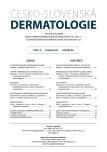-
Medical journals
- Career
Cutaneous and Mucosal Candidoses
Authors: I. Kuklová
Authors‘ workplace: Dermatovenerologická klinika 1. LF UK a VFN, přednosta prof. MUDr. Jiří Štork, CSc.
Published in: Čes-slov Derm, 90, 2015, No. 2, p. 47-53
Category: Reviews (Continuing Medical Education)
Overview
Yeasts are opportunistic human pathogens which pathogenicity depends on the general condition of the macroorganism and its immune system, but also on the virulence of individual yeasts. Yeasts can cause both cutaneous and systemic infections. In typical cases they affect mucosa, skin, nails and gastrointestinal tract. However, under certain circumstances, they can infect any organ. Invasive candidiasis and candidaemia are the most frequent clinical manifestations of systemic fungal infections, which are also associated with the highest mortality. The article provides the review of the current knowledge of the candida taxonomy, of the clinical picture, of the diagnosis and of the therapy of these diseases.
Key words:
candidose – C. albicans – taxonomy – clinical picture – diagnosis – therapy
Sources
1. ACHKAR, J. M., FRIES, B. C. Candida Infections of the Genitourinary Tract. Clin. Microbiol. Rev., 2010, 23, 2, p. 253–273.
2. BADER, O. MALDI-TOF-MS-based species identification and typing approaches in medical mycology. Proteomics, 2013, 13, 5, p. 788–799.
3. BODEY, G. P., MARDANI, M., HANNA, H. A. et al. The epidemiology of Candida glabrata and Candida albicans fungemia in immunocompromised patients with cancer. Am. J. Med., 2002, 112, p. 380–385.
4. DONDERS. G., BELLEN, G., BYTTEBIER, G., VERGUTS, L., HINOUL, P., WALCKIERS, R., STALPAERT, M., VEREECKEN, A., VAN ELDERE, J. Individualized decreasing-dose maintenance fluconazole regimen for recurrent vulvovaginal candidiasis (ReCiDiF trial). Am. J. Obstet. Gynecol., 2008, 199, 6, p. 613.
5. DUERR, A., HEILIG, C. M., MEIKLE, S. F., CU-UVIN, S., KLEIN, R. S., ROMPALO, A., SOBEL, J. D. Incident and persistent vulvovaginal candidiasis among human immunodeficiency virus-infected women: risk factors and severity. Obstet. Gynecol., 2003, 101, p. 548–556.
6. FRAGNER, P. Lékařská mykologie. Praha: Státní zdravotnické nakladatelství, 1967. 345 s. ISBN 08-069-67.
7. HABER, J. et al. Stanovisko odborných společností k indikaci a použití antimykotik se systémovým účinkem. Anest. intenz. Med., 2005, 1, p. 72–77.
8. HABER, J. Lipidový komplex amfotericinu B – jeho role mezi ostatními antimykotiky v léčbě invazivní kandidózy. Analýza klinických studií. Remedia, 2007, 4, 17, 5, p. 511 – 523.
9. MAŠATA, J., JEDLIČKOVÁ, A. a kol. Infekce v gynekologii a porodnictví. Praha: Maxdorf, 2004. 371 s. ISBN 80-7345-038-0.
10. McMILLAN, A., YOUNG, H., OGILVIE, M. M., SCOTT, G. R. Clinical practice in sexually transmissible infections. 2002, Saunders, 591 s. ISBN 0702025380.
11. MENDLING, W., BRASCH, J. Guideline vulvovaginal candidosis (2010) of the German Society for Gynecology and Obstetrics, the Working Group for Infections and Infectimmunology in Gynecology and Obstetrics, the German Society of Dermatology, the Board of German Dermatologists and the German Speaking Mycological Society. Mycoses, 2012, 55, Suppl 3, p. 1–13.
12. PANACKAL, A. A., GRIBSKOV, J. L., STAAB, J. F. et al. Clinical Significance of Azole Antifungal Drug Cross-Resistance in Candida glabrata. J. Clin. Microb., 2006, 44, p.1740–1743.
13. PAPPAS, P. G., KAUFFMAN, C. A., ANDES, D., BENJAMIN, D. K. JR., CALANDRA et al. Clinical practice guidelines for the management of candidiasis: 2009 update by the Infectious Diseases Society of America. Clin. Infect. Dis., 2009, 48, p. 503–535.
14. REED, B. D., ZAZOVE, P., PIERSON, C. L., GORENFLO, D. W., HORROCKS, J. Candida transmission and sexual behaviors as risks for a repeat episode of Candida vulvovaginitis. J. Womens Health (Larchmt.) 2003, 12, p. 979–989.
15. SOBEL, J. D. Vulvovaginal candidosis. Lancet, 2007, 369, p. 1961–1971.
16. SOBEL, J. D., CHAIM, W., NAGAPPAN, V., LEAMAN, D. Treatment of vaginitis caused by Candida glabrata: use of topical boric acid and flucytosine. Am. J. Obstet. Gynecol., 2003, 189, p. 1297–1300.
17. VOTAVA, M. Lékařská mikrobiologie speciální. Neptun, 2003, 495 s. ISBN 80-90 2896-6-5.
18. WOLF, K. et al. Fitzpatrick s Dermatology in general medicine. 7th edition, Mc Graw Hill, 2008, 2402 s. ISBN 978-0-07-146690-5.
19. WORKOWSKI, K. A., BERMAN, S. M. Sexually transmitted diseases treatment guidelines. 2006, MMWR Recommend. Rep., 55, p.1–94.
Labels
Dermatology & STDs Paediatric dermatology & STDs Gynaecology and obstetrics
Article was published inCzech-Slovak Dermatology

2015 Issue 2
Most read in this issue- Cutaneous and Mucosal Candidoses
- Penile Lymphoedema in Association with Inflammatory Bowel Disease
- Small Melanomas
- Therapy of the Recurrent Basal Cell Carcinoma by Vismodegib
Login#ADS_BOTTOM_SCRIPTS#Forgotten passwordEnter the email address that you registered with. We will send you instructions on how to set a new password.
- Career

